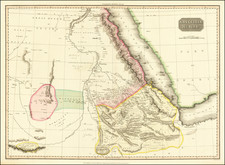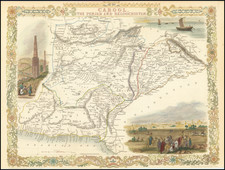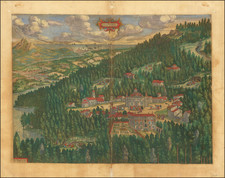Executed with the precision characteristic of Jean Baptiste Bourguignon d'Anville, this 1780 map delineates the regions of ancient Phoenicia and the surroundings of Damascus, employing the best available modern information. Its creation during the Age of Enlightenment encapsulates a period marked by a rigorous reevaluation of classical knowledge through empirical observation and methodical cartography.
D'Anville's representation of Phoenicia captures the narrow, fertile coastal strip historically inhabited by the Phoenicians, a Semitic-speaking people celebrated for their maritime trade and the spread of a phonetic alphabet. This map shows the delineations of their city-states, such as Tyre and Sidon, which played pivotal roles in the expansion of ancient trade networks across the Mediterranean.
The areas surrounding Damascus are charted with equal exactitude, emphasizing the city's strategic location within a rich oasis. Damascus’s prominence as an ancient metropolis, in the midst of many important trading routes, reveals its significance in trade and as a nexus of cultural and religious plurality through successive empires.
The map's topographical features, including the Anti-Lebanon mountain range, the Beqaa Valley, and the course of the Orontes River, are meticulously recorded. Such geographical elements are not merely of natural interest but indicate the terrain's influence on historical patterns of settlement, defense, and agriculture.
D'Anville's cartographic endeavor, devoid of conjecture, offers a document of empirical value and historical authenticity. For the collector and scholar, it represents an archival piece that encapsulates the geographical understanding of the time and bears witness to the enduring legacy of a region central to the narrative of human civilization.
Jean-Baptiste Bourguignon d’Anville (1697-1782) was one of the foremost French geographers of the eighteenth century. He carried out rigorous research in order to create his maps, which greatly developed the technical proficiency of mapmaking during his lifetime. His style was also simpler and less ornate than that of many of his predecessors. It was widely adopted by his contemporaries and successors.
The son of a tailor, d’Anville showed cartographic prowess from a young age; his first map, of Ancient Greece, was published when he was only fifteen years old. By twenty-two, he was appointed as one of the King’s géographes ordinaire de roi. He tutored the young Louis XV while in the service to the Crown. However, royal appointment did not pay all the bills, so d’Anville also did some work for the Portuguese Crown from 1724. For example, he helped to fill out Dom João V’s library with geographical works and made maps showing Portugal’s African colonies.
D’Anville disapproved of merely copying features from other maps, preferring instead to return to the texts upon which those maps were based to make his own depictions. This led him to embrace blank spaces for unknown areas and to reject names which were not supported by other sources. He also amassed a large personal map library and created a network of sources that included Jesuits in China and savants in Brazil. D’Anville’s historical approach to cartography resulted in magnificently detailed, yet modern and academic, maps. For example, his 1743 map of Italy improved upon all previous maps and included a memoir laying out his research and innovations. The geographer also specialized in ancient historical geography.
In 1773, d’Anville was named premier géographe de roi. In 1780, he ceded his considerable library to the Ministry of Foreign Affairs to be used for as a reference library for diplomats. D’Anville is best known for several maps, including his map of China, first published in 1735, and then included with Du Halde’s history of that country (the Hague, 1737). His map of Africa (1749) was used well into the nineteenth century.










![[ Biblical Names for Palestine ]. Carte de La Palestine Ancienne et Moderne avec le Sud du Liban et de l'Anti-Liban et les régions situées à l'est du Jourdain et de la Mer Morte, pour servir à l'étude de la Bible par A. Legendre [Map of Ancient and Modern Palestine with Southern Lebanon and Anti-Lebanon and the regions east of the Jordan and the Dead Sea, for use in the study of the Bible by A. Legendre]](https://storage.googleapis.com/raremaps/img/small/85737.jpg)

![[Hand-Drawn Map Showing the Extent of the Ottoman Empire]](https://storage.googleapis.com/raremaps/img/small/99654.jpg)

![[Cyprus, Holy Land, Syria Middle East] Tabula Asiae IIII](https://storage.googleapis.com/raremaps/img/small/100937.jpg)